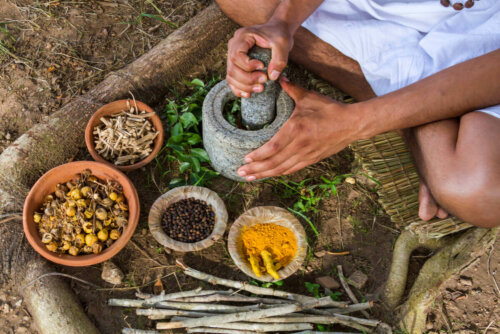The Health Benefits of an Ayurvedic Diet


Written and verified by the nutritionist Anna Vilarrasa
Ayurveda is one of the oldest traditional medical practices. It was developed in the Indian subcontinent. It’s currently recognized as one of the formal healthcare systems in the country, and the Ayurvedic diet is one of its pillars.
In Sanskrit, the word Ayurveda means science or knowledge of life. It emphasizes health and disease prevention through lifestyle, massage, meditation, and certain herbal remedies.
Continue reading to find out more about this way of life.
The Ayurvedic diet
This is more about eating healthy and not a diet per se. The main objective is to maintain your personal balance because you are what you eat. Overall, there are three different types of dosha defined as a series of individual attributes and their base is body type, personality, and predominant element. Thus, doshas are key to optimal development.
The doshas are:
- Vata is quick-minded, flexible, and creative. They tend to be thin with a tendency for colds, digestive problems, and difficulty focusing.
- The Pitta type is intelligent, hard-working, firm, and medium build. They’re prone to inflammation, have a healthy appetite, and typically no digestion problems.
- Kapha is calm and affectionate, strong, and resistant, and has difficulty losing weight. They’re often constipated.

Find out how to Improve Your Well-being with Turmeric and Lemon Water
In addition to following the right type of diet for your dominant personality, the Ayurvedic one is based on a series of guidelines and routines you must adhere to.
The most prominent for all types of people are:
- Eat three meals a day to allow completion of the digestion cycle without interruption.
- Eat at least 3 hours before going to bed.
- Eat until you’re satisfied, not full.
- Give priority to fresh, wholesome food.
- Include the 6 basic flavors in each of the meals.
- Eat consciously and in a relaxed environment.
Types of food
Ayurveda has established guidelines on what, how, and when to eat depending on your type of body or predominant dosha. There are detailed recommendations on the types of food you must include in your diet depending on whether Vata, Pitta, or Kapha predominate.
Vata
These people need a nourishing diet comprised of cooked dishes at a warm temperature and mild seasoning. They need to maintain a regular schedule and their diet must include the following:
- Oatmeal and rice
- Eggs, chicken, and fish
- Fermented dairy products
- Legumes in limited amounts
- Sweet, ripe, and juicy fruit
- Soaked almonds, walnuts, and seeds in general
- Sesame oil
- Turmeric, cumin, coriander, and ginger for seasoning
They should limit their consumption of:
- Red meats
- Hard cheeses
- Astringent dried fruits such as blueberries, apples, and pomegranates
- Raw vegetables and mushrooms
Check out this Efficient Natural Honey and Turmeric Remedy
Pitta
Cold lightly seasoned dishes that are sweet, refreshing, and bitter are best for this type of person. A vegetarian diet is a good option for them and they must include the following on their diet:
- Barley, rice, oats, and wheat
- Chicken and turkey as sources of animal protein
- Milk, ghee, butter, and unsalted cheese
- Legumes in small amounts (the best are black lentils, chickpeas, and mung beans)
- Sweet fruit such as apples, blueberries, and dates
- Salads and raw vegetables
- Sunflower and pumpkin seeds (from time to time)
- Cardamom, cinnamon, fennel, and turmeric
The dominant pitta personality should avoid the following:
- Products of animal origin, especially shellfish and eggs
- Red and yellow lentils
- Acidic fruit and vegetables such as tomatoes, radishes, chili peppers, raw onion, and garlic
- Most seeds and nuts because they’re oily
- Hot spices
Kapha
The most recommended diet for this dosha is one in which hot, light, and dry foods predominate. Also, bitter, astringent, and spicy flavors have a preference. Thus, these are the best types of food for them:
- Buckwheat and millet
- Baked or roasted chicken, rabbit, and seafood
- Ghee and goat’s milk
- Red lentils, black and mung beans
- Mangoes, peaches, apricots, and pears
- Vegetables that grow above the ground, especially green leafy ones such as spinach, chard, and cabbage
- Pumpkin and sunflower seeds in small amounts
- Most spices: garlic and ginger in particular
Also, this dosha must avoid the following:
- Sweet potatoes, oats, and wheat
- Any type of dairy and fat, especially fried foods
- Overly sweet or sour fruit
- Root vegetables, such as turnips, beets, or radishes
- Seeds and nuts in general
- All sweeteners and salt

Pros and cons of the Ayurvedic diet
The set of routines and the types of food that are part of the Ayurvedic diet focus on improving the general state of health. Thus, these are some of its strengths and benefits:
- First, it promotes a healthy lifestyle that includes simple food.
- Plant-based food predominates and has many positive effects on the prevention of diseases.
- Also, it encourages mindful eating.
- Also, it’s a way of life.
- It can balance bodyweight via proper digestion, a better lipid profile, and a lower risk of chronic disease.
However, there are some things you must take into account before changing your lifestyle:
- Ayurveda is a way of life, not a diet, so it isn’t only about food; thus, you must adhere to it as a whole.
- It might be difficult to find some products in your city and adapt to their taste.
- Finally, it’ll require dedication to change the way you cook and eat.
Final recommendations for the Ayurvedic diet
You must consult an Ayurvedic specialist before making any major changes to your current diet and lifestyle. This is because they must determine your dosha and establish any existing or possible imbalances to treat.
Good organizational skills are key when it comes to sticking to this plan. Thus, anyone who follows it must dedicate a reasonable amount of time to adapt to new habits and new flavors.
All cited sources were thoroughly reviewed by our team to ensure their quality, reliability, currency, and validity. The bibliography of this article was considered reliable and of academic or scientific accuracy.
- Lad V. Food Guidelines for Basic Constitutional Types. The Ayurvedic Institute. 2018.
- Lad V. Ayurveda. A brief introduction and guide. The Ayurvedic Institute. 2016.
- Estrada Ramírez, Nadia Verónica, et al. “Dieta Ayurveda.” (2009).
- Payyappallimana U, Venkatasubramanian P. Exploring Ayurvedic Knowledge on Food and Health for Providing Innovative Solutions to Contemporary Healthcare. Front Public Health. Marzo 2016.4:57.
- Rao RV. Ayurveda and the science of aging. Journal of Ayurveda and Integrative Medicine. Diciembre 2018;9(3):225-232.
- Slavin JL, Lloyd B. Health benefits of fruits and vegetables. Advances in Nutrition. Julio 2012.3(4):506-515.
- Freidin, Betina, Matías Ballesteros, and Mariano Echeconea. “En búsqueda del equilibrio: salud, bienestar y vida cotidiana entre seguidores del Ayurveda en Buenos Aires.” Documento de trabajo 65 (2013).
- Gasperi, Patrícia De, Vera Raduns, and Ângela Rosa Ghiorzi. “Ayurveda diet and the nursing consultation: a care proposal.” Ciencia & saude coletiva 13.2 (2008): 495-506.
- Moreno Leguizamón, Carlos J. “Salud-enfermedad y cuerpo-mente en la medicina ayurvédica de la India y en la biomedicina contemporánea.” Antípoda. Revista de Antropología y Arqueología 3 (2006): 91-121.
This text is provided for informational purposes only and does not replace consultation with a professional. If in doubt, consult your specialist.








